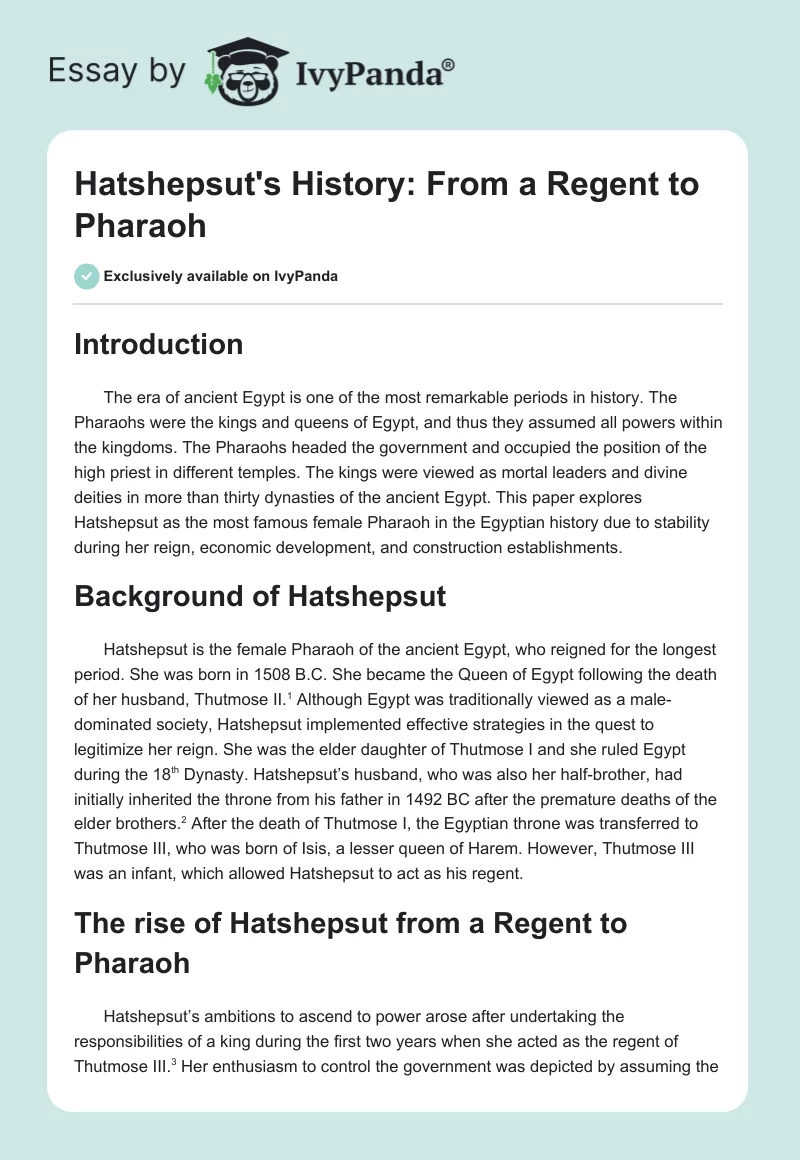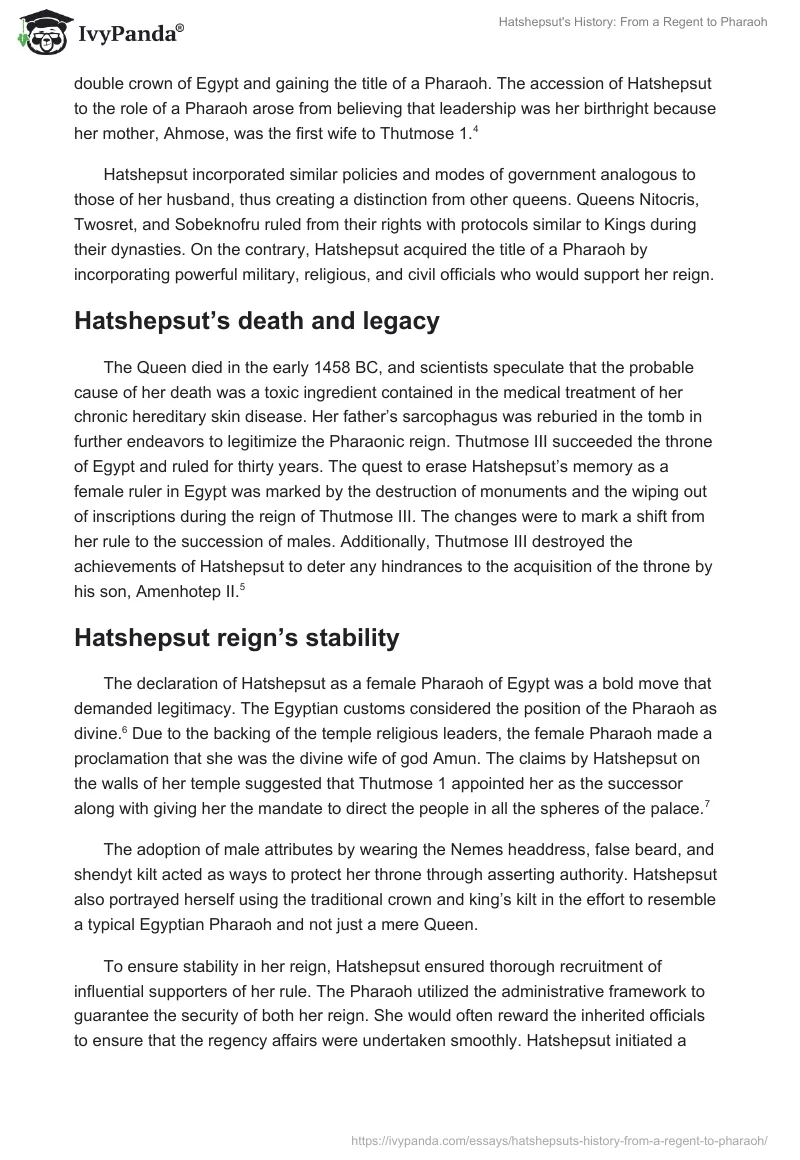Introduction
The era of ancient Egypt is one of the most remarkable periods in history. The Pharaohs were the kings and queens of Egypt, and thus they assumed all powers within the kingdoms. The Pharaohs headed the government and occupied the position of the high priest in different temples. The kings were viewed as mortal leaders and divine deities in more than thirty dynasties of the ancient Egypt. This paper explores Hatshepsut as the most famous female Pharaoh in the Egyptian history due to stability during her reign, economic development, and construction establishments.
Background of Hatshepsut
Hatshepsut is the female Pharaoh of the ancient Egypt, who reigned for the longest period. She was born in 1508 B.C. She became the Queen of Egypt following the death of her husband, Thutmose II. Although Egypt was traditionally viewed as a male-dominated society, Hatshepsut implemented effective strategies in the quest to legitimize her reign. She was the elder daughter of Thutmose I and she ruled Egypt during the 18th Dynasty. Hatshepsut’s husband, who was also her half-brother, had initially inherited the throne from his father in 1492 BC after the premature deaths of the elder brothers. After the death of Thutmose I, the Egyptian throne was transferred to Thutmose III, who was born of Isis, a lesser queen of Harem. However, Thutmose III was an infant, which allowed Hatshepsut to act as his regent.
The rise of Hatshepsut from a Regent to Pharaoh
Hatshepsut’s ambitions to ascend to power arose after undertaking the responsibilities of a king during the first two years when she acted as the regent of Thutmose III. Her enthusiasm to control the government was depicted by assuming the double crown of Egypt and gaining the title of a Pharaoh. The accession of Hatshepsut to the role of a Pharaoh arose from believing that leadership was her birthright because her mother, Ahmose, was the first wife to Thutmose 1.
Hatshepsut incorporated similar policies and modes of government analogous to those of her husband, thus creating a distinction from other queens. Queens Nitocris, Twosret, and Sobeknofru ruled from their rights with protocols similar to Kings during their dynasties. On the contrary, Hatshepsut acquired the title of a Pharaoh by incorporating powerful military, religious, and civil officials who would support her reign.
Hatshepsut’s death and legacy
The Queen died in the early 1458 BC, and scientists speculate that the probable cause of her death was a toxic ingredient contained in the medical treatment of her chronic hereditary skin disease. Her father’s sarcophagus was reburied in the tomb in further endeavors to legitimize the Pharaonic reign. Thutmose III succeeded the throne of Egypt and ruled for thirty years. The quest to erase Hatshepsut’s memory as a female ruler in Egypt was marked by the destruction of monuments and the wiping out of inscriptions during the reign of Thutmose III. The changes were to mark a shift from her rule to the succession of males. Additionally, Thutmose III destroyed the achievements of Hatshepsut to deter any hindrances to the acquisition of the throne by his son, Amenhotep II.
Hatshepsut reign’s stability
The declaration of Hatshepsut as a female Pharaoh of Egypt was a bold move that demanded legitimacy. The Egyptian customs considered the position of the Pharaoh as divine. Due to the backing of the temple religious leaders, the female Pharaoh made a proclamation that she was the divine wife of god Amun. The claims by Hatshepsut on the walls of her temple suggested that Thutmose 1 appointed her as the successor along with giving her the mandate to direct the people in all the spheres of the palace.
The adoption of male attributes by wearing the Nemes headdress, false beard, and shendyt kilt acted as ways to protect her throne through asserting authority. Hatshepsut also portrayed herself using the traditional crown and king’s kilt in the effort to resemble a typical Egyptian Pharaoh and not just a mere Queen.
To ensure stability in her reign, Hatshepsut ensured thorough recruitment of influential supporters of her rule. The Pharaoh utilized the administrative framework to guarantee the security of both her reign. She would often reward the inherited officials to ensure that the regency affairs were undertaken smoothly. Hatshepsut initiated a promotion program that covered the officials who pledged allegiance and loyalty during the initial years of her kingship.
Her reign was also distinguishable due to the extremely influential and prominent officials who composed the cabinet of trustworthy courtiers. Hapuseneb and Senenmut were selected to be top officials in Hatshepsut’s reign while the Amun domain would reward the elites who supported the government.
Hatshepsut ensured the steadiness of her reign by ensuring that peace was maintained to drive economic prosperity. However, she engaged in several multiple campaigns by leading the military in conducting expeditions in Nubia and Syria. Even though Thutmose III became the military leader of Hatshepsut’s army to gain the prerequisite training that was essential for every Pharaoh, some argue that the move was a scheme to alienate him from attaining the throne. Hatshepsut wanted to retain power by preoccupying Thutmose III with military affairs.
Economic development
Originally, the role of the Egyptian Pharaohs was to defend their native land from invasion by enemies. The reign of Hatshepsut was characterized by unity because the foreign policy was oriented to trade partnerships rather than war. During the twenty-two years of her reign, Egypt made remarkable progress in trade expansions both locally and beyond its boundaries. Favorable conditions for trade were ensured through the establishment of harmonious trading expeditions to the land of Punt as elaborated on the walls of Deir el-Bahri Temple.
During the period between the Middle and the New Kingdom in ancient Egypt, Hatshepsut aided in the formulation of trade agreements.
The funding of the trade mission to the land of Punt that occurred during the ninth year of her reign saw the exchange of goods and creation of wealth. Valuable assets were acquired from Punt including myrrh and frankincense. These commodities were essential cosmetics that were used in the various occasions and especially in religious ceremonies. Other goods from trade missions to the ancient Egypt and Punt during Hatshepsut’s governance included gold, ebony, ivory, resins, and black wood.
The external trade also aimed at the acquisition of slaves who would provide cheap labor in Egypt. Furthermore, the trading led to the importation of cheetah and giraffe skins alongside plants and wild animals such as monkeys and baboons. Hatshepsut also foresaw trading expeditions to Sinai and Byblos, thus gathering wealth and prosperity to Egypt during the 18th Dynasty.
Construction development during Hatshepsut reign
Hatshepsut is regarded as one of the prolific builders who were highly recognized in the ancient Egypt. The commissioning of mega construction projects in both Lower and Upper Egypt evidenced her efforts. As compared to the buildings that had been constructed between the 11th and the 14th Dynasties, the architectural structures under Hatshepsut’s regime were grander and numerous. The construction involved the deployment of qualified architects, for example of Ineni, who was a prominent government official with the role of heading constructions projects that were initiated by Thutmose 1 and II and Hatshepsut.
One of the remarkable architectural developments under Hatshepsut was the construction of monuments located in the temple of Karnack. The Karnack entailed a collection of pylons, chapels, and other buildings that transcended from the Middle to the New Kingdoms in the history of the ancient Egypt. The Pharaoh also led the renovation of the Karnak, which had been destroyed during wars by foreign kings in the Hyksos period. The construction of the obelisks, which had four walls and pointed pillars with a pyramid top, was also undertaken during the 18th Dynasty.
The mortuary temple of Hatshepsut is another superior construction that was developed in the ancient Egypt and it was formally referred to as the “holy of holies.” The temple was constructed between the 7th to the 22nd year of Hatshepsut’s reign. Senenmut was the royal architect while the temple had impressive monuments that depicted the greatness of the Pharaoh. The construction of the temple was strategic in nature.
The location of the temple was considered sacred, and it stood a few meters from where the female Pharaoh had planned the excavation of her tomb. The Mortuary Temple provided a location for worship as well as a place for depository of objects and food presented to the dead monarch. The buildings also housed storerooms, shrines, and a chapel where the priests would undertake the routine funerary ceremonies.
The construction development under the reign of the famous female Pharaoh included the red chapel, which was initially constructed as a shrine. The walls of the doorway of the chapel were made of gray diorite and black granite. The building stood out due to the prefabrication of stones. Hatshepsut started the construction of the chapel in the final years of her governance. However, Thutmose III, who became her predecessor, pulled down the building to assume his preferred architectural design.
Additionally, other building advancements comprise the Temple of the Pakhet. The temple was constructed under rock cliffs that faced the eastern direction of the Nile. The temple acted as the archive that stored great dedicatory information concerning Hatshepsut’s strategic plans and innovations. Nevertheless, the onset of the 19th Century saw the alterations of the inner decorations of the temple in the effort to erase the name of the female Pharaoh.
Conclusion
Even though the ancient Egypt is regarded as a male-dominated era, several female Pharaohs ascended to power. Hatshepsut is viewed as the most powerful of all the female Pharaohs in Egypt. She claimed to be the legitimate heir and the subsequent successor of Thutmose II. To ensure reign’s stability, Hatshepsut recruited loyal officials, and she would assume some male characteristics to assert her authority. The economic prosperity during her reign was marked by trade engagements with the land of the Punt. The construction developments, which were evident during Hatshepsut’s reign, include the Mortuary Temple, the Red Chapel, and the Temple of Pakhet among others.
Bibliography
Bader, Bettina. “Architecture, Power, and Religion: Hatshepsut, Amun, and Karnak in Context, by Warburton David.” Cambridge Archaeological Journal 24, no.1 (2014): 187-189. Web.
Callender, Gae. “The Red Chapel of Hatshepsut.” Teaching History 46, no.3 (2012): 4-13. Web.
Creasman, Pearce. “Hatshepsut and the Politics of Punt.” African Archaeological Review 31, no.3 (2014): 395-405. Web.
Ćwiek, Andrzej. “Old and Middle Kingdom Tradition in the Temple of Hatshepsut at Deir el-Bahari.” Studies and Texts 27, no.1 (2014): 62-95. Web.
Galán, José, Betsy Bryan, and Peter Dorman. Creativity and Innovation in the Reign of Hatshepsut: Occasional Proceedings of the Theban Workshop (Studies in Ancient Oriental Civilizations). Chicago: Oriental Institute of the University of Chicago, 2014. Web.


